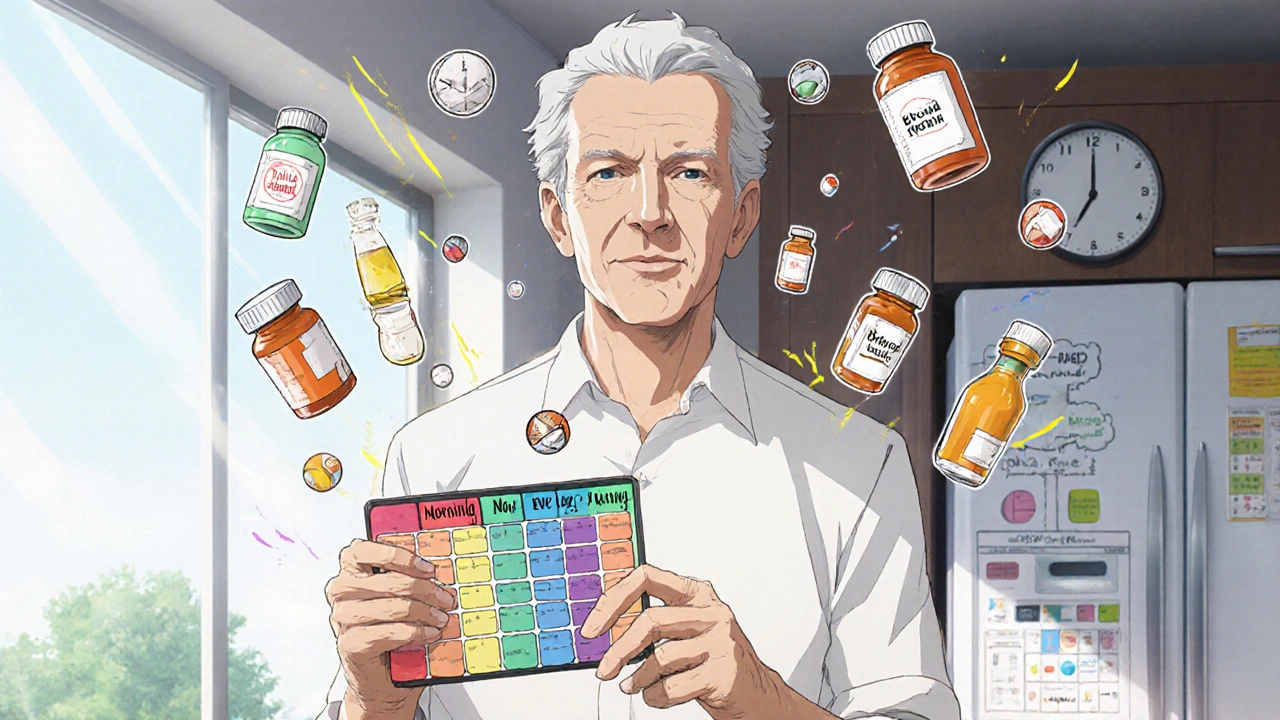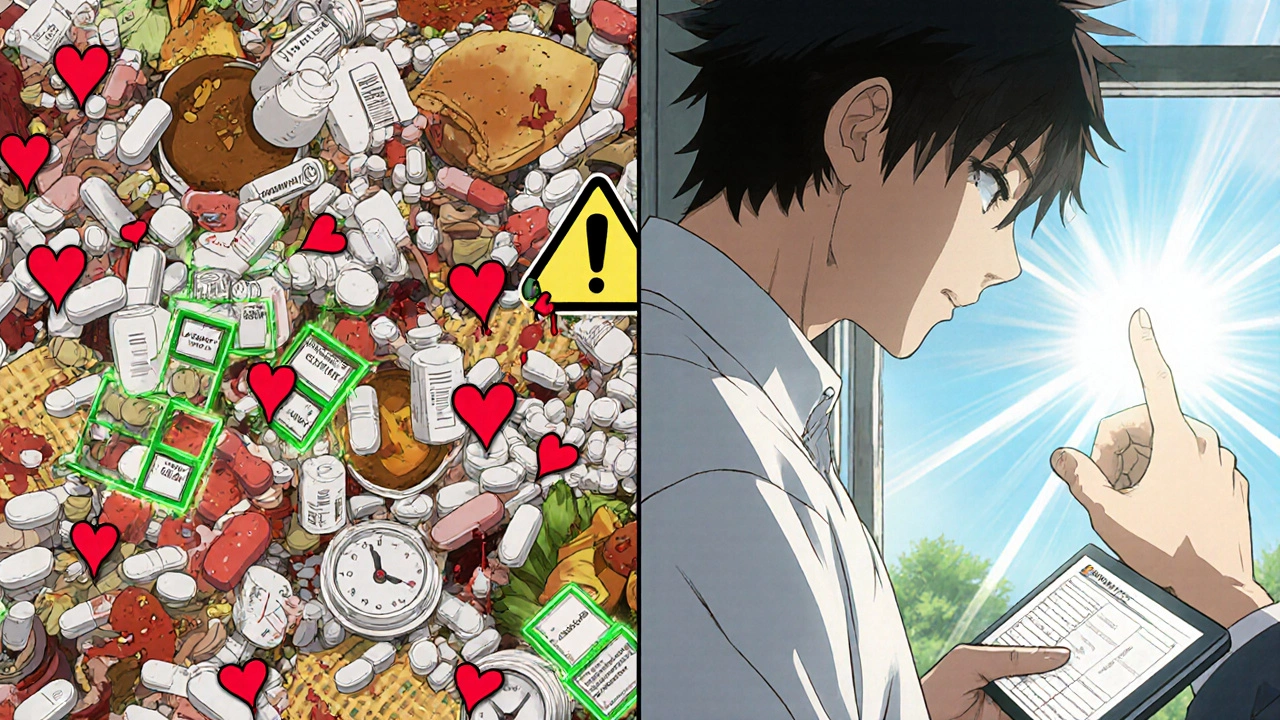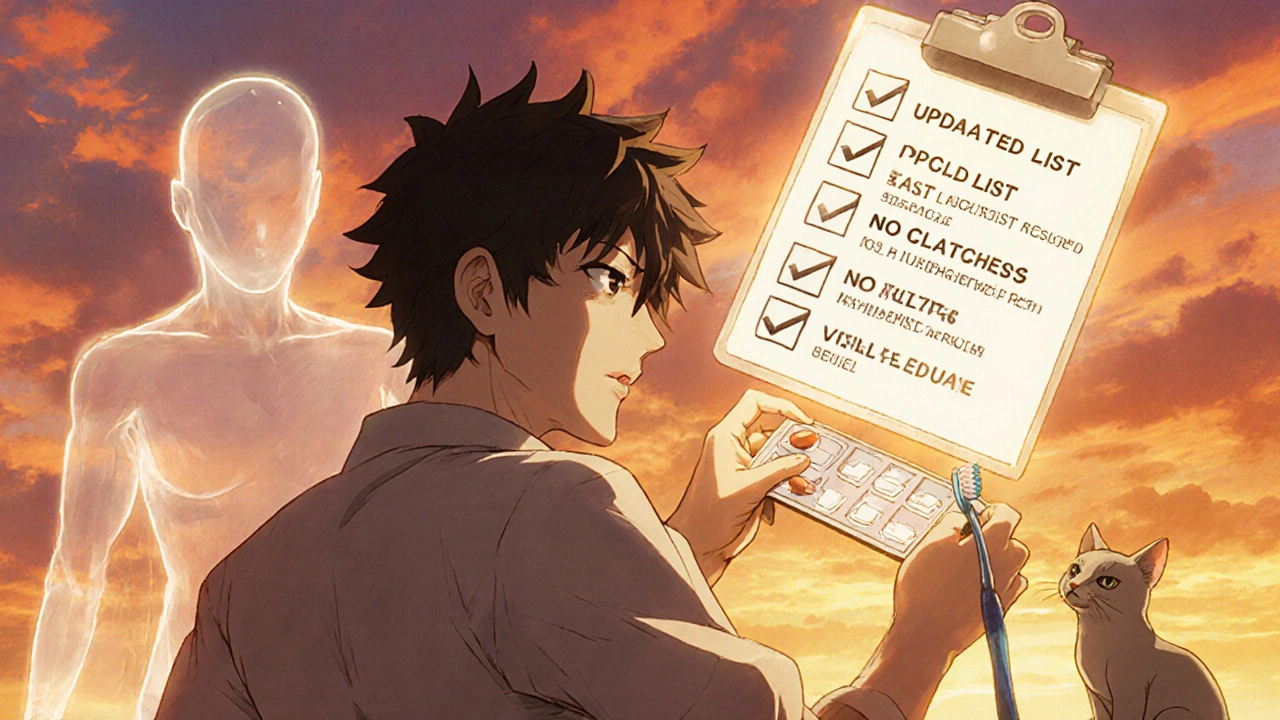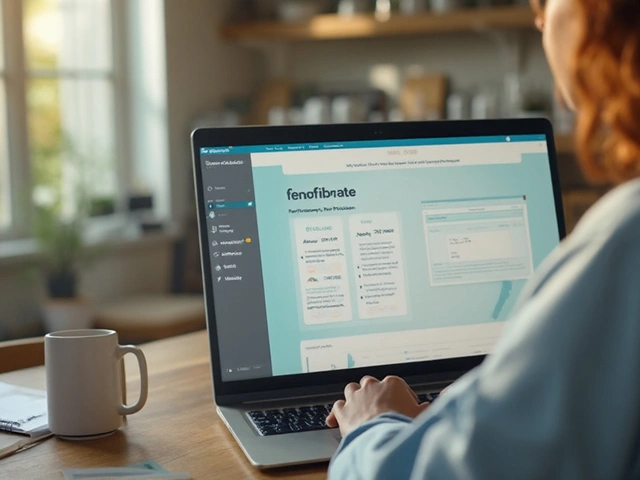
Managing multiple medications isn’t just about remembering to take them. It’s about taking them at the right time, in the right order, and without clashing with other drugs, food, or health conditions. If you’re on five or more medications, you’re not alone-nearly 40% of adults over 65 are. But here’s the real problem: medication interactions can turn a helpful treatment into a dangerous one. Dizziness, nausea, internal bleeding, or even organ damage can happen when drugs don’t play nice together. The good news? You can build a simple, foolproof schedule that cuts those risks dramatically.
Start with a Complete Medication List
Before you even think about timing, you need to know exactly what you’re taking. This includes prescriptions, over-the-counter painkillers, vitamins, herbal supplements, and even occasional meds like sleeping pills or antacids. Many people forget the non-prescription stuff, but that’s where half the problems start. Ibuprofen with blood thinners? That’s a bleeding risk. Calcium supplements with thyroid meds? That blocks absorption. A 2019 study found that patients who brought all their meds to a doctor visit-what’s called a "brown bag review"-had an average of 3.2 hidden discrepancies per person. That’s more than three mistakes hiding in plain sight. Write everything down: name, dose, why you take it, and how often. Don’t rely on memory. Use a notebook, a phone note, or a printed sheet. Update it every time you see a new doctor or get a new prescription. This list is your foundation. Without it, any schedule you build is just guessing.Use the Universal Medication Schedule (UMS) Framework
Forget vague instructions like "take twice daily" or "with meals." Those are confusing-even for people with high health literacy. The Universal Medication Schedule (UMS), developed by Northwestern University researchers and backed by the Agency for Healthcare Research and Quality, gives you four clear windows:- Morning: 6-10 AM
- Noon: 10 AM-2 PM
- Evening: 2-6 PM
- Bedtime: 8 PM-12 AM
Group by Timing, Not by Condition
Don’t organize your pills by disease. Group them by time. If you take a blood pressure pill, a statin, and a daily vitamin-all of which are morning meds-put them together. That makes it easier to remember. You’re not thinking, "What did my cardiologist say? What did my endocrinologist say?" You’re thinking, "What’s in the morning box?" This is where a pill organizer becomes essential. Use one with AM/PM compartments, or better yet, a 7-day box with four time slots per day. A 2018 meta-analysis found that using these organizers reduced dosing errors by 45%. That’s almost half the mistakes gone. Label each compartment clearly: "Morning," "Noon," etc. If you use color coding-red for heart meds, blue for thyroid-that’s even better. People on Reddit’s r/medhelp reported that color-coding helped them avoid mix-ups after years of confusion.
Watch Out for Food and Stomach Rules
Some meds need to be taken on an empty stomach. Others need food to work right-or to stop your stomach from getting upset. These rules aren’t optional. They’re science.- Levothyroxine (for thyroid): Must be taken alone, at least 30-60 minutes before breakfast. Calcium, iron, and coffee can block it completely.
- Statins (like atorvastatin): Work best when taken with dinner. That’s when your liver makes the most cholesterol.
- Antibiotics (like doxycycline): Don’t take with dairy. Calcium binds to them and stops absorption.
- NSAIDs (ibuprofen, naproxen): Always take with food to protect your stomach lining.
Separate Drugs That Clash
Some meds can’t be taken close together-even if they’re both morning pills. Calcium and thyroid meds? Keep them 2 hours apart. Iron and antibiotics? Same rule. Antacids can mess with absorption of many drugs, including some antidepressants and osteoporosis meds. The key is spacing. Use your UMS windows to create buffer zones. If you take a thyroid med at 7 AM, don’t take calcium at 8 AM. Wait until noon. If you take a blood thinner and an NSAID, don’t take them in the same window. Split them-morning and evening, for example. Your pharmacist can run a quick check using Lexicomp or similar tools. It takes 10-15 minutes per complex regimen, but it could save you a hospital trip.Synchronize Refills and Use Digital Help
If you’re taking five or more meds, getting them refilled on different days is a nightmare. One pharmacy says "next Monday," another says "next Wednesday." You run out of one, then another. That’s when missed doses happen. Ask your doctor or pharmacist about "90 x 4" prescribing: get a 90-day supply, filled four times a year. That means all your meds come due on the same day. It’s easier to manage, saves you trips, and cuts down on errors. The American Medical Association says this saves doctors up to two hours per day-and you, the patient, save stress. For tech-savvy users, apps like Medisafe or MyTherapy send reminders and track interactions. A 2021 study showed they improve adherence by 20-35% over paper. But here’s the catch: only 38% of people over 65 use them consistently. If you’re not comfortable with apps, stick with paper. A medication calendar with date and time entries improved adherence from 50% to 75% in chronic illness patients. The best tool is the one you’ll actually use.
Know the Red Flags
Even with the best schedule, things can go wrong. Watch for these signs:- Unusual dizziness or fainting
- Black or tarry stools
- Unexplained bruising or bleeding
- Severe nausea or vomiting
- Confusion or memory lapses
- Swelling in ankles or rapid weight gain
Review Every 3-6 Months
Your body changes. Your meds might too. A drug that was safe last year might not be now. Conditions like kidney or liver function can shift, changing how your body handles drugs. That’s why you need a medication review every 3-6 months. Bring your updated list to your doctor or pharmacist. Ask: "Is everything still necessary?" "Are there safer alternatives?" "Could any of these be combined?" A 2020 study showed that pharmacist-led reviews reduced drug interactions by 32% and cut emergency visits by 24%. That’s not a small win. That’s life-changing.Final Tip: Keep It Visible
Your schedule only works if you see it every day. Tape your medication chart to the fridge. Put your pill organizer next to your toothbrush. Set phone alarms labeled "Morning Meds" or "Bedtime Pill." If you forget, it’s not your fault-it’s the system’s fault. Make it impossible to miss. Building a safe medication schedule isn’t about perfection. It’s about consistency. It’s about using clear time blocks, separating risky combinations, and staying in tune with your body. You don’t need to be a doctor to do this. You just need to be organized-and willing to ask questions. The goal isn’t just to take your meds. It’s to take them safely.What if I miss a dose?
Don’t double up unless your doctor says to. Check the label or call your pharmacist. For most meds, if you remember within a few hours of the missed time, take it. If it’s close to the next dose, skip it. Missing one dose rarely causes harm, but doubling up can be dangerous-especially with blood thinners, insulin, or heart meds.
Can I use one pill organizer for all my meds?
Yes, but only if it has enough compartments. A 7-day, 4-times-daily organizer (AM/Noon/Evening/Bedtime) is ideal for people on five or more meds. Avoid simple AM/PM boxes if you need more than two time slots. If your meds require spacing (like calcium and thyroid), make sure you can separate them physically in the organizer.
Do herbal supplements really interact with meds?
Absolutely. St. John’s Wort can make birth control, antidepressants, and blood thinners less effective. Garlic and ginkgo can increase bleeding risk with aspirin or warfarin. Ginseng can raise or lower blood sugar. Always list supplements on your medication sheet. They’re not "natural" if they change how your prescription works.
Why do I need to update my list at every doctor visit?
Each doctor may add, remove, or change a med without knowing what others prescribed. A cardiologist might add a new beta-blocker, while your pain specialist gives you NSAIDs. Without a full list, they can’t see the big picture. Medication reconciliation-comparing what you’re taking with what’s on file-reduces errors by 48% during care transitions, according to AHRQ.
Is it safe to crush pills or open capsules?
Only if the label or pharmacist says so. Extended-release pills, enteric-coated capsules, and some blood pressure meds are designed to release slowly. Crushing them can cause too much drug to enter your system at once-leading to overdose. Always ask before altering how you take a pill.
If you’re juggling multiple medications, you’re not alone. But you don’t have to guess your way through it. Use the UMS, group by time, separate risky combos, and keep your list updated. The goal isn’t to memorize everything-it’s to create a system so simple, even on a bad day, you can’t get it wrong.
Write a comment
Your email address will not be published.





8 Comments
So let me get this straight-you’re telling me the government and Big Pharma don’t want us to know that the UMS is just a distraction so we don’t ask why we’re on 12 pills in the first place? I’ve been on 7 meds since 2018, and every time I ask my doctor to cut one, they say ‘it’s for your heart.’ But my heart’s fine. My liver? Not so much. They’re selling schedules, not solutions. This whole thing is a profit loop disguised as safety.
And don’t even get me started on ‘herbal supplements.’ Of course they interact. The FDA doesn’t regulate them because they’re scared of the herbal industrial complex. St. John’s Wort? That’s basically nature’s SSRIs. They don’t want you to know you can replace half your prescriptions with turmeric and meditation.
Update your list every 3 months? Nah. Burn the list. Stop trusting the system. Trust your body. It’s been screaming since 2019. You just stopped listening.
Also, your pharmacist? They’re paid by the pharmacy chain. They’re not your friend. They’re a sales rep with a white coat.
Bro, this is the most accurate thing I’ve read in years. I’m from Lagos, Nigeria, and here we don’t even have proper pharmacies-half the pills are expired or fake. But I still use the UMS. I write everything down on my phone, and I even took a picture of my pills and labeled them in Hausa so my auntie can help me when I’m dizzy.
And yes, garlic and ginkgo? They don’t play nice with warfarin. My uncle died because he took ginger tea with his blood thinner. No one told him. So I scream this from the rooftops: LISTEN TO YOUR PHARMACIST. They’re the only ones who care.
Also, I use a 7-day box with four slots. I bought it from a guy on the street for 500 naira. It’s not fancy, but it works. You don’t need an app. You need discipline.
And for the love of God, stop crushing pills. That’s how people end up in the ICU. I’ve seen it.
I just want to say how much this post means to people like me-caregivers for aging parents, folks juggling chronic illness, and those of us who feel invisible in the healthcare system.
My mom was on 11 meds. She forgot half of them. She’d take her thyroid pill with coffee. She’d crush her extended-release blood pressure pill because it was ‘too big.’ I cried every time I found her confused, staring at a pile of pills like they were a puzzle she couldn’t solve.
Then we started using the UMS. We got a 7-day organizer with color-coded labels. We taped the food rules to the fridge. We set alarms with actual voice recordings: ‘Mom, it’s 7 a.m. Time for your thyroid. No coffee for 30 minutes.’
It’s not glamorous. It’s not high-tech. But for 18 months, she’s had zero ER visits. No falls. No bleeding. No confusion.
This isn’t just about schedules. It’s about dignity. It’s about not being a burden. It’s about feeling like you still have control. Thank you for writing this. You saved lives today.
And if you’re reading this and you’re scared to ask your doctor about cutting meds? Do it. Ask. Even if you’re trembling. They’re supposed to help you-not just prescribe.
Let’s address the statistical manipulation here. The UMS claim of reducing misinterpretation from 34% to 6%? That’s a cherry-picked study from a Northwestern University grant-funded project with a sample size of 127 elderly patients in a single county. The JAMA study cited? They excluded patients with cognitive impairment. That’s not a population-wide solution. That’s a lab experiment dressed as public health policy.
Also, ‘40% of adults over 65 are on five or more meds’-yes. But why? Because of polypharmacy culture. The system incentivizes prescribing, not deprescribing. You’re being sold a Band-Aid while the hemorrhage continues.
And the claim that ‘color coding helped Reddit users’? That’s anecdotal. Reddit is not a peer-reviewed journal. The 45% reduction in dosing errors from pill organizers? Where’s the control group? Did they account for literacy, vision, or socioeconomic barriers?
This post reads like a pharmaceutical marketing pamphlet. The real problem isn’t scheduling-it’s a healthcare system that treats patients like inventory.
Also, ‘ask your pharmacist’-sure, if you can afford the $12 co-pay for a 10-minute consultation. In rural America, pharmacies are closing. In cities, pharmacists are overworked and underpaid. They can’t be your safety net.
Don’t trust the system. Question the data. And stop treating symptom management like a productivity hack.
India mein sab kuch sahi hai but yeh western system kyun follow kar rahe ho? Humare ghar mein 100 saal se dawa ka istemal hota hai without any stupid morning noon evening chart. My grandpa took 7 medicines and he lived to 98. He just ate roti, did yoga, and said prayers.
And why are you all scared of pills? Is this America? We don’t need apps or color codes. We have common sense. Why are you so dependent on technology? Just take your medicine when you remember. If you forget, you forget. Life goes on.
Also, herbal supplements? Of course they work! Turmeric is better than any NSAID. Garlic is better than aspirin. Why do you think Indian doctors don’t give you 10 pills? Because they know the body heals itself.
Stop listening to white doctors. They don’t know our bodies. We have 5000 years of wisdom. This UMS is just cultural imperialism.
And if you use an app? You are not Indian. You are a traitor.
Also, I don’t know what is Lexicomp but if it’s from USA then it’s fake.
My cousin took 3 pills and he died. But he was using an app. So app = bad. Tradition = good.
I really appreciate how detailed this is. I’ve been managing my own meds for 12 years now-hypertension, diabetes, depression-and I can say the UMS framework changed everything for me.
What I’ve learned is that consistency matters more than perfection. I’ve missed doses. I’ve taken a pill 20 minutes late. I’ve forgotten my vitamins for a week. But because I have a fixed window-morning, noon, evening, bedtime-I never feel guilty. I just reset.
My biggest win? I stopped taking my statin with grapefruit juice after reading this. I didn’t even know that was a thing. Now I take it with water at 8 p.m., no exceptions.
And yes, supplements matter. I used to take magnesium for sleep. Turns out it was messing with my thyroid med. My endocrinologist caught it during a routine check. We didn’t even know to ask.
I don’t use an app. I have a printed chart taped to my bathroom mirror. I check it every morning while brushing my teeth. Simple. Visible. Human.
This isn’t about being perfect. It’s about being aware. And awareness is the most powerful tool we have.
Yes. Yes. YES. This is the kind of practical, life-saving advice that gets buried under medical jargon.
I’m a nurse in Glasgow, and I’ve watched too many elderly patients end up in A&E because they mixed their blood thinner with ibuprofen or took their thyroid pill with their morning coffee. It’s heartbreaking. And it’s 100% preventable.
One of my patients, Margaret-84, diabetic, atrial fibrillation-used to have a shoebox full of pills. No labels. No order. She’d take them whenever she remembered. Then we introduced the UMS with a color-coded organizer. Two weeks later, she told me, ‘I feel like I’ve got my life back.’
And don’t underestimate the power of the ‘brown bag review.’ I do it every clinic day. Patients bring in everything-even the expired aspirin from 2015. And guess what? We find three to five interactions every time.
It’s not about being tech-savvy. It’s about being intentional. A piece of paper. A pill box. A pharmacist you trust. That’s all it takes.
Thank you for writing this. Someone needed to say it out loud.
Everyone’s talking about UMS and pill organizers like it’s the holy grail. But let’s be real-this only works if you’re middle-class, literate, and have access to a pharmacy that doesn’t charge you $200 for a 30-day supply. What about the people in rural Appalachia? Or the undocumented immigrants who can’t afford to refill their meds? Or the homeless who don’t have a fridge to tape a chart to?
And why are we still treating this like a personal responsibility issue? Why isn’t the system fixing this? Why are we putting the burden on seniors to become pharmacists?
Also, the ‘90 x 4’ refill thing? That’s great if your insurance covers it. Mine doesn’t. I have to pay $400 out of pocket to get all my meds at once. So I choose: thyroid or blood pressure? Which one do I skip this month?
And don’t even get me started on the ‘natural remedies’ myth. You think turmeric is safer than warfarin? That’s not wisdom. That’s dangerous ignorance.
Stop praising individual discipline. Fix the system. People aren’t failing because they’re lazy. They’re failing because the system abandoned them.